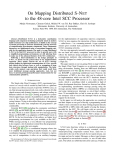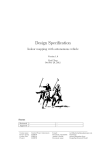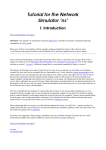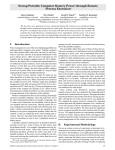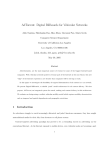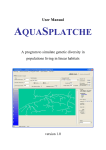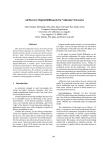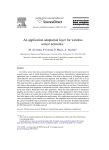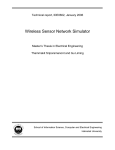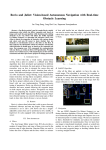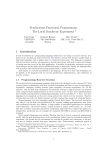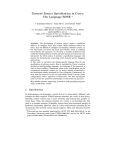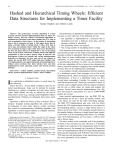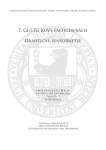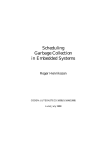Download Supporting Wireless Application Development via
Transcript
Proceedings of the International Multiconference on
Computer Science and Information Technology pp. 853–860
ISBN 978-83-60810-14-9
ISSN 1896-7094
Supporting Wireless Application Development via
Virtual Execution
Nicholas M. Boers, Pawel Gburzyński, Ioanis Nikolaidis
Wlodek Olesinski
Department of Computing Science
University of Alberta
Edmonton, Alberta, Canada T6G 2E8
{boers,pawel,yannis}@cs.ualberta.ca
Olsonet Communications
51 Wycliffe Street
Ottawa, Ontario, Canada K2G 5L9
[email protected]
Abstract—We introduce our “holistic” platform for building
wireless ad hoc sensor networks and focus on its most representative and essential virtualization component: VUE2 (the Virtual
Underlay Emulation Engine). Its role is to provide a vehicle
for authoritative emulation of complete networked applications
before physically deploying the wireless nodes. The goal is to be
able to verify those applications exhaustively before programming
the hardware, such that no further (field) tests are necessary. We
explain how VUE2 achieves this goal owing to several facilitating
factors, most notably the powerful programming paradigm
adopted in our platform. As implied by the holistic nature of
the discussed system, our presentation touches upon operating
systems, simulation, network protocols, real-time systems, and
programming methodology.
I. I NTRODUCTION
LTHOUGH simple wireless devices built from low-end
components are quite popular these days, one seldom
hears about serious wireless networks within this framework.
While it is not a big challenge to implement simple broadcasters of short packets, it is quite another issue to turn them
into collaborating nodes of a serious ad hoc wireless system.
Apparently, many popular ad hoc routing schemes proposed
and analyzed in the literature [1]–[6] address devices with a
somewhat larger resource base. To make matters worse, some
people believe that such devices must be programmed in Java
to make serious applications possible [7].
In this context, efforts to introduce an order and methodology into programming small devices often meet with skepticism and shrugs, the common misconception being that
one will not have to wait for long before those devices
disappear and become superseded by larger ones capable of
supporting “serious” programming platforms. This is not true.
Despite the ever decreasing cost of microcontrollers, we see
absolutely no reduction in the demand for the ones at the
lowest end of the spectrum. On the contrary: their low cost
and power requirements enable new applications and narrow
the gap between the publicized promise of ad hoc wireless
sensor networking and the actual state of affairs. Similar to
the impossibility of having the three desirable properties of
food (cheap, fast, and good tasting) present at the same time,
wireless sensor networking has problems being cheap, ad hoc,
and useful, all at once.
A
The goal of our platform is to enable the rapid creation
of wireless ad hoc sensor networks using the smallest and
cheapest devices available today. In our networks, such devices
are capable of ad hoc routing while offering enough processing
power to cater to complex applications involving distributed
sensing and monitoring. To thoroughly test and evaluate our
work, we turn to virtualization.
At the lowest level, virtualization can be accomplished by
simulating in software a particular instruction set, i.e., by
means of a bytecode interpreter. This approach has been the
basis even for commercial grade products, but within the
scope of our paper the primary example is Maté [8]. The
main shortcomings of such an approach are (a) the interpreter
overhead (in terms of both space and time), (b) a lack of
back ends for compilation from familiar high-level languages
into the invented bytecode format, and (c) the need to define
the interaction with peripheral components, e.g., transceivers,
in a manner consistent with the invented instruction set. If
the virtual machine is fairly well established, e.g., JVM, then
one can claim that at least (b) and (c) have been addressed.
However, there seems to exist no successful virtual machine
geared to sensor devices. For example, even virtual machines
intended for small footprint devices (like Dalvik VM [9], part
of the Google Android platform [10]) are “heavyweight” for
sensor nodes. In addition (as it happens with Dalvik VM), not
all of the language libraries are implemented, raising questions
on the extent that VMs can be ported to small platforms
without compromising fidelity.
On the other end of the spectrum, we find virtualization by
means of an API provided by the underlying operating system.
The API is accessible using familiar high-level languages like
C or C++. One example is the POSIX API. A platform that
can provide run-time emulation of an API can be thought of as
successfully virtualizing at the level of the API. Unfortunately,
commodity OS APIs are very broad, and the abstractions
that they promote are expensive to implement on a sensor
device. For example, the Berkeley sockets API is a powerful,
albeit expensive, way to abstract network communication.
Even worse, it is not a useful abstraction for small devices
that do not even implement a TCP/IP stack.
We believe that a viable compromise between the two
extremes is to introduce a small footprint OS, to specify
853
854
PROCEEDINGS OF THE IMCSIT. VOLUME 3, 2008
the API supported by the OS, and to subsequently offer
virtualization at the level of that API. Note that in following
this approach, we do not need a new toolchain for code
production, since we neither have to invent a new higher
level language nor do we need to procure a compiler back
end for a new (invented) instruction set. In this paper, we
focus on the interplay of PicOS (our operating system for tiny
microcontrolled devices [11]) and VUE2 (the Virtual Underlay Emulation Engine for realistically simulating networked
applications programmed in PicOS).
II. P IC OS
The most serious problem with implementing non-trivial,
structured, multitasking software on microcontrollers with
limited RAM is minimizing the amount of memory resources
needed to sustain a thread. The most troublesome component
of the thread footprint is its stack, which must be preallocated
to every thread in a safe amount sufficient for its maximum
possible need.
PicOS strikes a compromise between the complete lack
of threads and overtaxing the tiny amount of RAM with
fragmented stack space. A thread contains a number of checkpoints that provide preemption opportunities. In the imposed
structured organization of a thread, we try to (a) avoid locking
the CPU at a single thread for an extensive amount of time
and (b) use the checkpoints as a natural and useful element
of a thread’s specification to enhance its clarity and reduce its
structure’s complexity. These ideas lie at the heart of PicOS’s
concept of threads, which are structured like finite state
machines (FSMs) and exhibit the dynamics of coroutines [12],
[13] with multiple entry points and implicit control transfer.
The value of FSM-like programming abstractions is evident
to anyone developing networking protocols, as most protocols
tend to be described, or even formalized, as communicating
FSMs. In addition, programming using a coroutine paradigm
is a fairly well-accepted approach and has survived in modern
languages (e.g., “stackless” Python [14] and more recently
Ruby [15]). The only general criticism coroutines receive is
that the lack of arbitrary preemption might allow CPU-bound
tasks to monopolize the CPU. This is not a fundamental
problem, because a CPU-bound task can be broken down into
a sequence of states to allow preemption at state transitions.
However, an important element of our view is to use the
coroutine paradigm as a means to discourage CPU-intensive
tasks on sensors. Instead, any tasks of this kind should be
either moved to data collectors (i.e., full-scale computers) or
delegated to specialized (possibly reconfigurable) hardware.
On a historical note, we arrived at PicOS indirectly as
a step in the evolution of our network simulation system
SMURPH [16], [17]. As SMURPH underwent a number of enhancements, its capability for rigorous representation of all the
relevant engineering problems occurring in detailed protocol
design turned it into a specification system. Although oriented
towards modeling networks and their protocols, SMURPH
became a de facto general purpose specification and simulation
package for reactive systems [18], [19].
A highly practical project—the development of a lowcost wireless badge—inspired the idea to implement a
complete executable environment for microcontrollers based
on SMURPH’s programming paradigm. After developing a
SMURPH model for the badge, the most reliable way of
transporting it to the real device was to implement the target microprogram on top of a tiny execution environment
mimicking SMURPH’s mechanism for multithreading and
event handling [11]. Incidentally, that mechanism facilitated
a stackless implementation of multithreading. Consequently,
the resultant footprint of the complete application was trivially small (< 1 KB of RAM), while the application itself
was expressed as a structured and self-documenting program
strictly conforming to its SMURPH model.
A. The anatomy of a PicOS thread
Fig. 1 shows a sample PicOS thread. In this C code, new
keywords and constructs are straightforward macros handled
by the standard C preprocessor. The entry statements mark
the different states of the thread’s FSM.
Fig. 1: Code for a sample PicOS thread.
A thread can lose the CPU when (a) it explicitly relinquishes
control at the boundary of its current state (e.g., release) or
(b) a function call blocks (e.g., tcv_rnp if no new packets
are available). In both cases, the CPU returns to the scheduler,
which can then allocate it to another thread. Whenever a thread
is assigned the CPU, execution continues in that thread’s
current state.
Before executing release, a thread typically issues a
number of wait requests identifying one or more events to
resume it in the future (e.g., when for IPC and delay for timed
events). The collection of wait requests issued by a thread in
every state describes the dynamic options for its transition
function from that state.
B. System organization
The organization of PicOS is shown in Fig. 2. VNETI
(Versatile NETwork Interface) acts as a layerless networking
module, whereby the equivalents of “protocol stacks” are implemented as plug-ins. The set of operations available to plugins involve queue manipulations, cloning packets, inserting
NICHOLAS M. BOERS ET. AL: SUPPORTING WIRELESS APPLICATION DEVELOPMENT VIA VIRTUAL EXECUTION
855
special packets, and assigning to them the so-called disposition
codes representing various processing stages. Any protocol
can be implemented within this paradigm, with TARP (our
Tiny Ad hoc Routing Protocol [20], [21]) being the most
prominent example. The modus operandi of VNETI is that
packets are claimed by the protocol plug-ins as well as the
physical interface modules (PHY) at the relevant moments of
their life in the module’s buffer space. There is no explicit
concept of processing hierarchy, e.g., enforcing traditional
layers; thus, packets in VNETI are handled “holistically.”
Fig. 3: The structure of a VUE2 model.
The close relationship between PicOS and our discrete-time
event-driven network simulator named SMURPH [16], [17]
makes it possible to automatically transform PicOS praxes
into SMURPH models with the intention of executing them
virtually. VUE2 implements the PicOS API within SMURPH,
and in some cases, it can simply transform PicOS keywords
into their SMURPH counterparts. To represent the physical
environment of a PicOS praxis, it also provides a collection
of event-driven interfaces. This way, a praxis can be compiled
and executed in the environment shown in Fig. 3, with all
the relevant physical elements of its node replaced by their
detailed SMURPH models. Notably, exactly the same source
code of VNETI is used in both cases.
the model execution too long to wait for the results), and
all that matters is the abstract delays separating the virtual
events. For example, two threads in SMURPH may be semantically equivalent, even though one of them may exhibit
a drastically shorter execution time than the other, e.g., due
to more careful programming and/or optimization. In PicOS,
however, the threads are not (just) models but they run the
“real thing.” Consequently, the execution time of a thread may
directly influence the perceived behavior of the PicOS node.
In this context, the following two assumptions made the VUE2
project worthwhile:
1) PicOS programs are reactive, i.e., they are practically
never CPU bound. The primary reason why a PicOS
thread is making no progress is that it is waiting for
a peripheral event rather than the completion of some
calculation.
2) If needed (from the viewpoint of model fidelity), an
extensive period of CPU activity can be modeled in
SMURPH by appropriately (and explicitly) delaying
certain state transitions.
In most cases, we can ignore the fact that the execution
of a PicOS program takes time at all and only focus on
reflecting the accurate behavior of the external events. With
this assumption, the job of porting a PicOS praxis to its VUE2
model can be made simple. To further increase the practical
value of such a model, SMURPH provides for the so-called
visualization mode of execution. In that mode, SMURPH tries
to map the virtual time of modeled events to real time, such
that the user has an impression of talking to a real application.
This is only possible if the network size and complexity allow
the simulator to catch up with the model execution to real
time; otherwise, a suitable slow motion factor can be applied.
A. Time flow
B. Model scope
The fidelity of the emulation environment depends to a
great extent on appropriately handling the flow of time, i.e.,
equating emulated time with real time. In SMURPH, as in all
event-driven simulators, the time tags associated with events
are purely virtual. The actual (physical) execution time of a
SMURPH thread is essentially irrelevant (unless it renders
SMURPH threads are programmed in C++, which we
have extended with new keywords and constructs. A special
preprocessor (dubbed SMPP) processes the SMURPH source
to produce pure C++ code. PicOS praxes are programmed
in plain C with the assistance of a few macros (see Fig. 1)
expanded by the standard C preprocessor. Putting trivial syn-
Fig. 2: The structure of PicOS.
All API functions interfacing the application (called the
praxis in PicOS) to VNETI have the same status as those
interfacing the praxis to the kernel, i.e., they are formally
system calls. As a thread in PicOS can only be resumed at
a state boundary, a potentially blocking system call requires
a state argument (e.g., the first argument in the function call
tcv_rnp in Fig. 1).
III. VUE2
856
PROCEEDINGS OF THE IMCSIT. VOLUME 3, 2008
tactic issues aside, the most fundamental difference between
the two systems is the fact that a SMURPH model must
describe the whole network (i.e., a multitude of nodes, each
of them running a private copy of the application), while a
complete PicOS praxis is a single program that runs on a
single device. This difference becomes more pronounced if
the network consists of nodes running different praxes, a not
uncommon scenario.
We make extensive use of C++ classes to accomplish the
conversion from a single-application node to a multi-node (and
possibly multi-application) emulator. In the conversion, each
PicOS praxis becomes a C++ class. Most of the praxis functions and variables become member functions and attributes
of the class, respectively. For truly global (node indifferent)
functions and data, the compiler need not associate them with
a specific class and can instead keep them global. When the
emulator executes and builds the network, it represents each
node as an object (i.e., instance of the appropriate class).
Beyond the “adaptation layer” for PicOS praxes, the VUE2
extension to SMURPH implements detailed models for the
physical hardware (Section III-C). In terms of communication,
SMURPH brings in a powerful generic wireless channel
model [22] that provides enough flexibility to implement
arbitrarily complex propagation models. All of this potential
for modeling allows us to confidently and comprehensively
verify applications before uploading the code to physical
nodes.
C. Peripherals
The current version of VUE2 implements detailed models for a significant subset of PicOS-supported peripherals
that include serial communications (UART), physical sensors, general-purpose I/O (GPIO), digital-to-analog converters (DACs), analog-to-digital converters (ADCs), and lightemitting diodes (LEDs). Some of these devices, such as
the GPIO pins, may require input or produce output. For
such devices, VUE2 offers a variety of peripheral-dependent
options. In the case of the GPIO pins, the developer can
describe their I/O via (a) the initial network description (for
input only), (b) external files (to pre-generate/script input and
log output), or (c) communication over a network socket. In the
third case, VUE2 provides a special program named udaemon
that allows the developer to interactively read from and write
to the peripheral.
The udaemon application is a fundamental component in
the interactive emulation of a wireless sensor node and its
peripherals. The initial window in the GUI (Fig. 4, top) allows
the user to open peripheral-specific windows for individual
emulated nodes. For example, the UART window (Fig. 4,
bottom) allows two-way communication with a node over
a virtual serial interface. This udaemon application provides
access to all VUE2 -modeled peripherals.
IV. A PPLICATION D EVELOPMENT
We have used both PicOS and VUE2 together to implement
and test a variety of practical wireless network applications
Fig. 4: A screen shot of udaemon showing its primary window
(top) and interaction with an individual node over UART
(bottom).
such as passively monitoring environmental conditions and
actively tracking the movement of indoor objects. In the
subsections that follow, we introduce a few of our applications
and highlight VUE2 ’s ability to accommodate their specific
(often peripheral-related) virtualization requirements.
A. EcoNet
The EcoNet project, conceived with the Earth Observation
Systems Laboratory at the University of Alberta, aims to
monitor an environment’s sunlight, temperature, and humidity.
Wireless sensor nodes distributed throughout an environment
periodically measure these characteristics and then report them
to a sink node. In this scenario, a single deployment uses two
separate applications: a collector to read/transmit sensor values
and an aggregator to receive sensor values. The collector
application uses the PicOS sensor functionality to read the
current values from its analog sensors.
During execution, the collector application calls the PicOS
function read_sensor to obtain the latest values from a
device’s sensors. When running on the hardware, PicOS obtains these values using the hardware’s ADC. In the emulator,
the user can provide the sensor values graphically on a pernode basis using slider widgets. During an experiment, simply
dragging the sliders interactively changes the sensor values
visible at a node.
B. Mousetraps
The Mousetrap project, conceived with researchers in the
University of Alberta’s biology department, aims to monitor
the common live-catching trap. When a rodent enters one of
our traps, the movement of the ramp triggers a physical switch
that we have added to the trap. The triggering of the switch
creates a message that the node sends to its associated sink.
In the above network, nodes run a single application that uses
PicOS’s pin monitoring/notifier functionality for digital input.
The API for the pin notifier functionality includes functions
to enable, disable, and check it. An application that uses it will
NICHOLAS M. BOERS ET. AL: SUPPORTING WIRELESS APPLICATION DEVELOPMENT VIA VIRTUAL EXECUTION
wait for the predefined event PMON_NOTEVENT. On the actual
hardware, this event is implemented through interrupt handlers
and some auxiliary functions, e.g., needed for debouncing the
switch. In the emulator, we use essentially the same code, and
the user can graphically change the value of a monitored input
pin using a button in the GUI.
C. Tags and Pegs
The Tags and Pegs project at Olsonet aims to locate a
sensor-enabled object within a sensor-enabled environment.
Nodes in the network periodically broadcast short messages,
and then other nodes use received signal strengths to perform
localization. This deployment also uses two applications: one
for mobile nodes and one for static nodes. To obtain signal
strength values, nodes use PicOS’s standard packet reception
functions.
When the application calls the PicOS function net_rx, the
application can retrieve a received packet from VNETI, and at
the same time, the corresponding signal strength. In the hardware, the signal strength comes from the radio transceiver. For
the emulator, SMURPH’s generic wireless model calculates
signal strengths for all virtual receptions, and the virtualization
of the PicOS API uses these calculated values. From the
application’s perspective, there is no difference between the
hardware and virtual environment.
V. C ASE S TUDY: P ING
In this section, we describe a simple ping application to
illustrate how our platform transforms a single set of source
files into code suitable for compilation with both the hardware
(PicOS) and the emulator (VUE2 ). In this example, two nodes
run identical copies of the software.∗ When powered on,
a node immediately begins to broadcast unaddressed ping
packets that contain a locally maintained sequence number.
Whenever a node receives such a ping packet, it broadcasts
an acknowledgment that contains the received sequence number. Upon receiving an acknowledgement with the last sent
sequence number, a node increments its locally maintained
sequence number and immediately broadcasts another ping
packet. If a ping packet goes unacknowledged, a node retransmits the ping after a predetermined delay.
Before presenting code, the term thread (used loosely in
Section II) requires some clarification. In the context of
the source code, our platform makes a distinction between
processes with and without arguments. By doing so, we can
improve compatibility between the hardware and emulator
targets. We call a process that expects a typed data argument
on initialization a strand. Many instances of a strand may
exist at any given time, where each operates on its own local
(private) data. We call a process that tends to operate on global
data and does not accept such an argument a thread. Only
one instance of a thread may exist at any given time.
We logically divide the ping application into three processes. In our platform, execution begins at the thread root
∗ The application’s complete source code is available online at
http://tinyurl.com/67a4t6.
857
(Fig. 5a, right), which is akin to the function main in a
traditional C program. In a strand named sender (Fig. 5a,
left), we place the code that transmits ping packets. We use
a strand so that we can pass it the retransmission delay as
an argument (in this case, line 34 sets the delay to about two
seconds). Finally, we place the code for packet reception and
acknowledgement generation in a thread named receiver
(not shown).
Consider first the thread named root (Fig. 5a, right). The
keyword entry identifies a state boundary and its argument
identifies the state name. This thread contains a single state
named RS_INIT. The first three lines of this state essentially
serve as a constructor to (a) register a physical device with
VNETI, (b) register a protocol plug-in with VNETI, and
(c) open a session using that device and protocol. After some
error handling code, this thread continues to enable the radio’s
transmitter and receiver along with starting the previously
introduced processes sender and receiver.
It is quite possible for a single application to support a
variety of different physical radio transceivers. Such a case
might arise where a particular deployment’s specific characteristics later dictate the best hardware. VNETI’s abstractions
make this type of flexibility possible. For each supported
radio transceiver, the VNETI API provides a single function with the prefix phys_ to register the physical device
(e.g., Fig. 5a:25). To support multiple radios, developers can
use trivial preprocessor directives (e.g., #if and #endif) to
call the appropriate phys_ function. Beyond this initialization
stage, most applications require no further changes to switch
between different transceivers.
Another noteworthy point is VNETI’s protocol plug-in registration using the function tcv_plug(...) (e.g., Fig. 5a:26).
By registering the null protocol plug-in for the ping application, calls to functions in the VNETI API provide the
programmer with a more or less direct connection to the
network. The programmer then has much flexibility to manage
the packet overhead. Beyond the null plug-in, our platform
also implements the Tiny Ad hoc Routing Protocol (TARP)
to perform the ad hoc routing that we mentioned in our
introduction. Given our plug-in oriented approach, users can
implement further protocols as desired.
The remaining VNETI API functions begin with the prefix
tcv_ and primarily serve as state and buffer management.
Table I briefly describes some of the tcv_ functions relevant
to the presented code.
In Fig. 5a, left, we present the code for the strand sender.
In our platform, we define a number of data types to provide
consistent variable sizes between the different targets. The
keyword word that appears in the definition of sender
identifies the type of its data argument (the word type is
a 16-bit unsigned value). Later in the strand, the user can
access this data argument using the (implicit) variable data.
Upon entering the state SN_SEND, code checks whether the
node received an acknowledgement for the last ping. If so, it
immediately proceeds to send another ping. If not, it (a) sets a
timer to delay before rebroadcasting the ping and (b) waits for
858
PROCEEDINGS OF THE IMCSIT. VOLUME 3, 2008
Fig. 5: Excerpts from the ping application’s source code both before and after preprocessing.
NICHOLAS M. BOERS ET. AL: SUPPORTING WIRELESS APPLICATION DEVELOPMENT VIA VIRTUAL EXECUTION
TABLE I: Some of the most common VNETI API functions
and their descriptions.
Function
Description
tcv_plug
Configures a protocol plug-in for the network
interface; in the ping application, the null plugin provides a more or less direct connection to
the network.
tcv_open
Opens a session and returns a session descriptor (akin to a file descriptor).
tcv_control
Allows the application to change various parameters associated with the transceiver; in
the ping application, we use it to enable the
transmit and receive functionality of the radio.
tcv_rnp
Acquires the next packet queued for reception
at the session.
tcv_wnp
Requests a packet handle from VNETI in order
to send a new outgoing packet.
tcv_left
Determines the length of a packet acquired by
tcv_rnp.
tcv_endp
Indicates explicitly the moment when a packet
has been processed and is no longer needed.
a signal (IPC) on the address of last_ack. The receiver
process (not shown) triggers the address of last_ack when
it receives an expected acknowledgement. By waiting for
this signal in sender, the application can then immediately
advance the sequence number and send out a new ping packet.
The programmer’s effort amounts to writing code similar to
that presented in Fig. 5a. Note that the context for this code
is a single node and it is plain C code, albeit enhanced with
new “keywords” to improve clarity and simplify programming
that we have implemented as preprocessor macros. Since the
code is plain C, compiling for PicOS simply uses the standard C preprocessor and compiler. For VUE2 , a specialized
preprocessor makes the more complicated transition to C++
code where multiple applications and nodes must operate in a
single simulation environment that preserves the state of those
individual nodes.
A. Preprocessing
In Fig. 5b and c, we show the changes made to sender by
the respective preprocessor to prepare the code for compilation
with PicOS and VUE2 . In this subsection, we describe some
of the changes along with the reasoning behind them.
The first thing to notice is that in both cases the code’s
general structure remains the same. The user-written finite
state machine using our strand/entry “keywords” becomes
a switch on a variable containing the current state. In the
PicOS case, the preprocessor substitutes state names with
integer constants because the labels are #define preprocessor
directives. For VUE2 , the symbolic names remain because
an enumerated type represents states and thus the compiler
introduces the integer constants rather than the preprocessor.
In the VUE2 code, notice the appearance of several new
variables (i.e., TheStation and TheState). These variables
(and others) arise in the transition from a single-node (hardware) environment to a multi-node (simulated) environment.
859
The simulator represents each node in the network as an object, and the variable TheStation points to the node currently
being simulated. Another global variable named TheProcess
identifies the current process (e.g., sender) within that node
that the simulator is evaluating. Finally, a global variable
named TheState holds an integer that identifies the current
state within that process. At any point, these three variables
collectively describe the current state of the simulation.
Notice that all accesses to system calls and node-specific
variables within the user’s application use the pointer
TheStation (e.g., Fig. 5c:V04-V07,V10). At different places
in the preprocessed code, the single object is typecast to
either a PingNode or a PicOSNode. The derivation of the
relevant classes is as follows. SMURPH provides a base class
to represent a piece of hardware running in the network named
Station. VUE2 then introduces the notion of a PicOSNode
as a specialized type of station and thus derives it from
Station. At this level, VUE2 defines the PicOS system calls
(including those for VNETI) and internal state variables. From
here, VUE2 derives a further class that is protocol plug-in
specific; it contains the functions and variables necessary to
implement the plug-in. In this case, we use the null protocol
plug-in and thus this further subclass is of the type NNode.
Note that VUE2 also provides a class TNode for nodes that run
the TARP protocol plug-in. Finally, the class representing the
actual application (in this case PingNode) inherits from the
protocol-specific class (in this case NNode) and further defines
the processes and variables of the user’s application. When
starting a simulation, VUE2 builds all of the network nodes
using the lowest-level (and most complete class), which in this
case is PingNode. To see the different typecasts, first look to
line V04, which typecasts to PingNode when accessing nodeprivate application variables, and then to lines V05 and V06,
which typecast to PicOSNode for making system calls.
Notice that the C++ version contains additional labels
on lines V03, V12, and V20 that begin with the text
__state_label_. When the simulator comes across the
keyword proceed (e.g., lines V11 and V23), it saves the next
state in the variable TheState and then returns control to the
scheduler to make the state transition. The scheduler may not
immediately return control to the process if other events occur
at the same time. When the process does resume, the switch
statement on the variable TheState moves the process into
the appropriate state. Sometimes, SMURPH users will want
to make a transition that does not involve the scheduler. In
these cases, using the command sameas (not shown) rather
than proceed accommodates an immediate transition using
the label __state_label_ along with a goto statement. Note
that none of the code written for VUE2 /PicOS can currently
make use of the sameas functionality.
Readers may be unfamiliar with the construct
do
... while (0);
introduced on lines V11 and V23. It results from a macro
expansion of our keyword proceed. Essentially, this code is
a C idiom to define a macro consisting of multiple statements
that has the syntactic rights of a single statement.
860
PROCEEDINGS OF THE IMCSIT. VOLUME 3, 2008
In both the PicOS and VUE2 preprocessed code, name mangling occurs. In PicOS, preprocessing appends the characters
zzz_, zz_, or x_ to functions and variables internal to PicOS
in an attempt to avoid conflicts. In VUE2 , some similar mangling occurs plus further mangling on node-private variables
where the processor appends _na_ for similar reasons.
VI. C ONCLUSION
In this paper, we described our “holistic” platform for
building wireless ad hoc sensor networks and focused on
its most representative and essential component: VUE2 (the
Virtual Underlay Emulation Engine). Using it, developers
can write applications in C, rather than a new programming
language or bytecode, and then easily target to both hardware
nodes and our emulator.
Through the development of several applications, we have
found that the finite state machine paradigm allows for the
natural representation reactive applications. By using VUE2
during the development stage, we can test our applications
exhaustively in a virtual environment before investing time to
program physical hardware. When we later move our applications to the hardware, they perform within our expectations.
ACKNOWLEDGMENT
The authors would like to thank the Natural Sciences and
Engineering Research Council (NSERC) and the Informatics
Circle of Research Excellence (iCORE) for helping fund this
research.
R EFERENCES
[1] C. Perkins and P. Bhagwat, “Highly dynamic Destination-Sequenced
Distance Vector routing (DSDV) for mobile computers,” in Proc. of
SIGCOMM’94, Aug. 1993, pp. 234–244.
[2] T.-W. Chen and M. Gerla, “Global state routing: a new routing scheme
for ad-hoc wireless networks,” in Proc. of ICC’98, June 1998.
[3] V. Park and M. Corson, “A performance comparison of TORA and ideal
link state routing,” in Proc. of IEEE Symposium on Comp. and Comm.,
June 1998.
[4] J. Li, J. Jannotti, D. D. Couto, D. Karger, and R. Morris, “A scalable location service for geographic ad hoc routing,” in Proc. of the ACM/IEEE
Intl. Conference on Mobile Computing and Networking (MOBICOM’
00), 2000, pp. 120–130.
[5] C. Perkins, E. B. Royer, and S. Das, “Ad-hoc On-demand Distance
Vector routing (AODV),” February 2003, Internet Draft: draft-ietfmanet-aodv-13.txt.
[6] D. B. Johnson and D. A. Maltz, “Dynamic Source Routing in ad hoc
wireless networks,” in Mobile Computing, Imielinski and Korth, Eds.
Kluwer Academic Publishers, 1996, vol. 353.
[7] T. Henderson, J. Park, N. Smith, and R. Wright, “From motes to
Java stamps: Smart sensor network testbeds,” in Intelligent Robots and
Systems, Las Vegas, NV, Oct. 2003, pp. 799–804.
[8] P. Levis and D. Culler, “Maté: A tiny virtual machine for sensor
networks,” in Proc. of the 10th Intl. Conference on Architectural Support
for Programming Languages and Operating Systems (ASPLOS-X), San
Jose, CA, Oct. 2002, pp. 85–95.
[9] [Online]. Available: http://www.dalvikvm.com/
[10] [Online]. Available: http://code.google.com/android/
[11] E. Akhmetshina, P. Gburzyński, and F. Vizeacoumar, “PicOS: A tiny
operating system for extremely small embedded platforms,” in Proc. of
ESA’03, Las Vegas, Jun. 2003, pp. 116–122.
[12] O. Dahl and K. Nygaard, “Simula: A language for programming and
description of discrete event systems,” Norwegian Computing Center,
Oslo, Introduction and user’s manual, 5th edition, 1967.
[13] G. Birthwistle, O. Dahl, B. Myhrhaug, and K. Nygaard, Simula Begin.
Oslo: Studentlitteratur, 1973.
[14] A. Gustafsson, “Threads without the pain,” Social Computing, vol. 3,
no. 9, pp. 34–41, 2005.
[15] D. Thomas, C. Fowler, and A. Hunt, Programming Ruby: The Pragmatic
Programmer’s Guide.
The Pragmatic Programmers, 2004, second
edition.
[16] P. Gburzyński, Protocol Design for Local and Metropolitan Area Networks. Prentice-Hall, 1996.
[17] W. Dobosiewicz and P. Gburzyński, “Protocol design in SMURPH,” in
State-of-the-art in Performance Modeling and Simulation, J. Walrand
and K. Bagchi, Eds. Gordon and Breach, 1997, pp. 255–274.
[18] K. Altisen, F. Maraninchi, and D. Stauch, “Aspect-oriented programming
for reactive systems: a proposal in the synchronous framework,” Verimag
CNRS, Research Report #TR-2005-18, Nov. 2005.
[19] B. Yartsev, G. Korneev, A. Shalyto, and V. Ktov, “Automata-based
programming of the reactive multi-agent control systems,” in Intl.
Conference on Integration of Knowledge Intensive Multi-Agent Systems,
Waltham, MA, Apr. 2005, pp. 449–453.
[20] W. Olesinski, A. Rahman, and P. Gburzyński, “TARP: a tiny ad-hoc routing protocol for wireless networks,” in Australian Telecommunication,
Networks and Applications Conference (ATNAC), Melbourne, Australia,
Dec. 2003.
[21] P. Gburzyński, B. Kaminska, and W. Olesinski, “A tiny and efficient
wireless ad-hoc protocol for low-cost sensor networks,” in Proc. of
Design Automation and Test in Europe (DATE’07), Nice, France, Apr.
2007, pp. 1562–1567.
[22] P. Gburzyński and I. Nikolaidis, “Wireless network simulation extensions in SMURPH/SIDE,” in Proc. of the 2006 Winter Simulation
Conference (WSC’06), Monetery, California, Dec. 2006.








